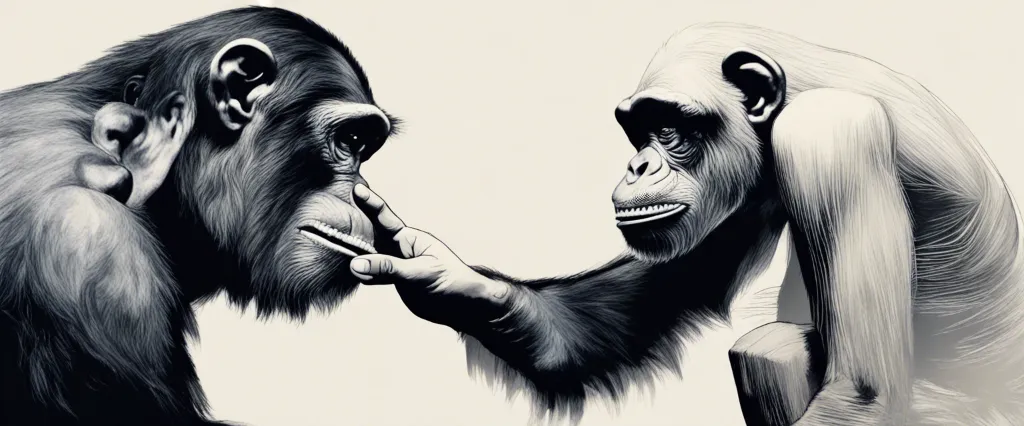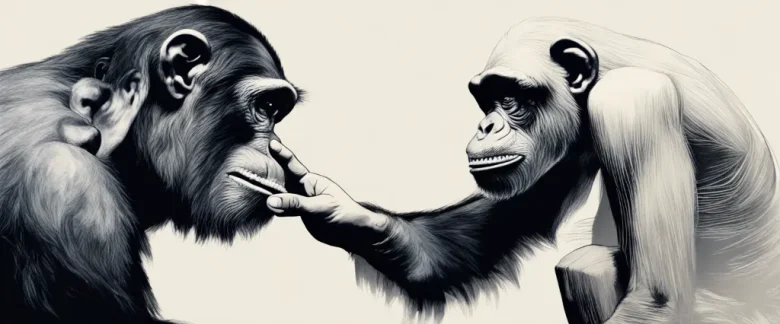
In “The Third Chimpanzee,” Jared Diamond unravels the remarkable and often controversial journey of humanity, examining our remarkable similarities to other animals while highlighting our unique abilities. Renowned for his groundbreaking works such as “Guns, Germs, and Steel” and “Collapse,” Diamond is a renowned geographer, anthropologist, and Pulitzer Prize-winning author. With a captivating blend of scientific research, historical analysis, and personal anecdotes, he sheds light on the puzzling question of why Homo sapiens have thrived, while closely related species such as Neanderthals and chimpanzees have declined or faced extinction.
Chapter 1: The Origins of Humans
Chapter 1 of “The Third Chimpanzee” by Jared Diamond explores the origins of humans and their unique evolutionary path. Diamond brings forth the idea that humans share more genetic similarities with chimpanzees than any other living creature, hence the title of the book.
The chapter begins by discussing how humans have always been fascinated by their origins. Diamond highlights the various theories proposed by scientists to explain human evolution, ranging from religious beliefs to scientific research. He emphasizes the significance of genetic evidence in understanding our journey.
Diamond then delves into the similarities between humans and chimpanzees, both genetically and behaviorally, presenting compelling evidence that we share a common ancestor. He discusses the remarkable communication and social behaviors exhibited by chimpanzees, shedding light on the roots of our own behavior.
Next, Diamond explores the distinguishing features that make humans unique among the animal kingdom. These include our ability to use language, create art, and manipulate our environment. He argues that these traits are extensions of behaviors developed during evolutionary stages, rather than purely unique human traits.
Furthermore, Diamond theorizes that the genetic similarities between humans and chimpanzees extend beyond physical characteristics and into behavioral traits. This suggests that our more destructive behaviors, such as warfare and genocide, are not exclusive to humans but rather have precedents in the animal world.
In conclusion, Chapter 1 of “The Third Chimpanzee” establishes the common ancestry between humans and chimpanzees, highlighting the genetic and behavioral similarities between the two species. Diamond draws attention to the unique characteristics of humans that have developed through evolution and challenges the perception of human exceptionalism.
Chapter 2: Language and Communication
Chapter 2: “Language and Communication” of Jared Diamond’s book The Third Chimpanzee explores the origins and evolution of human language and its significance in our unique ability to communicate complex thoughts and ideas.
Diamond begins by emphasizing that human language sets us apart from other animals and plays a fundamental role in our societies. He compares our closest relatives, the chimpanzees, who lack advanced language skills, highlighting the vast differences in our abilities to share knowledge and coordinate collective activities.
The chapter delves into the different aspects of human communication, beginning with the development of oral language. Diamond investigates how speech evolved and suggests that our ancestors likely possessed a complex set of vocalizations, gradually gaining the ability to articulate a wider range of sounds over time. He discusses the fascinating diversity of human languages, highlighting their shared structural characteristics and their power to shape our perception of the world.
Written language is another topic covered in this chapter. Diamond examines the history and impact of writing systems, emphasizing their importance in the preservation and transmission of information across generations. He also explores the development of symbolic writing, such as hieroglyphs and cuneiform, and the subsequent revolution brought about by the invention of alphabetic writing.
Moreover, Diamond investigates the relationship between language and artistic expression, exploring how language and visual art have both enabled humans to share their experiences and emotions more effectively. He emphasizes the role of storytelling as a way to pass down cultural knowledge and explores the evolution of music as a form of emotional communication.
In summary, Chapter 2 of The Third Chimpanzee explores the pivotal role of language and communication in human societies. Diamond highlights the uniqueness of human language, discusses its origins and evolution, and explores the profound impact it has had on our ability to share knowledge, express emotions, and shape our collective experience.
Chapter 3: Human Culture
Chapter 3 of Jared Diamond’s book, “The Third Chimpanzee,” explores the concept of human culture and its distinction from animal behavior. Diamond argues that culture is the defining feature that separates humans from other species, including our closest relatives, the chimpanzees.
The chapter begins by highlighting the diversity of human cultures and their vast differences in behaviors and beliefs. Diamond emphasizes that humans possess the ability to pass down learned knowledge from one generation to another, a process he refers to as “cumulative cultural evolution.” This accumulation of knowledge allows for the rapid development and transmission of complex tools, technologies, language, and social norms.
The author discusses a wide range of cultural practices, some of which are universal across human societies, such as art, music, and ritual. Diamond argues that these practices serve both practical and psychological purposes, enabling humans to express emotions, build social bonds, or transmit important information.
Furthermore, Diamond examines the destructive aspects of human culture, such as warfare, discrimination, and environmental degradation. He believes that some of these harmful practices stem from our evolutionary heritage as an aggressive species, coupled with our capacity for cultural innovation. This combination has led to both impressive achievements, like space travel, and devastating consequences, like genocide.
Throughout the chapter, Diamond critically examines the consequences of human culture and highlights the need for a thoughtful and responsible approach in preserving our collective future. He poses questions about the long-term consequences of cultural evolution, including the potential for self-destruction.
In summary, Chapter 3 of “The Third Chimpanzee” explores the uniqueness of human culture, its vast diversity, and its impact on both our species and the environment. Diamond’s analysis sheds light on the power and potential pitfalls of cultural evolution, urging readers to consider the important roles they play in shaping the future of our society and planet.
Chapter 4: Human Sexuality
Chapter 8: The Future of Humans
Chapter 8 of “The Third Chimpanzee” by Jared Diamond is titled “The Future of Humans” and explores potential future scenarios for our species based on our past behaviors and current predicaments.
Diamond begins by discussing the issue of overpopulation, highlighting how human population growth has increased exponentially in the recent past. He argues that this rapid growth creates a strain on the planet’s resources, potentially leading to environmental degradation and even collapse.
Taking lessons from history, Diamond examines how past civilizations have been faced with similar challenges and have either succeeded or failed in finding sustainable solutions. He emphasizes the importance of understanding the impact of our actions on the environment and the need for cooperation and long-term thinking to find viable solutions to global crises.
The author then delves into the dangers posed by our advanced technology. He contemplates the risks of nuclear weapons, biological weapons, and genetic engineering, pointing out that although these advancements have the potential to improve human lives, they also have the potential to cause massive harm.
Furthermore, Diamond discusses the impact of globalization on the spread of diseases and explores how our modern lifestyles and primarily sedentary behaviors are contributing to the rise of chronic diseases. He warns of the need to address these health issues before they become even more prevalent in future generations.
In conclusion, Diamond emphasizes that the future of humans depends on our ability to learn from history, make informed decisions about resource consumption, and foster cooperation on a global scale. By acknowledging the challenges we face and confronting them with intelligence and foresight, he suggests that there is hope for our species to overcome these obstacles and ensure a sustainable and prosperous future.
After Reading
In Jared Diamond’s thought-provoking book, The Third Chimpanzee, the author explores the striking similarities between Homo sapiens and the two other species of chimpanzees, Pan troglodytes and Pan paniscus. Through extensive research and compelling arguments, Diamond presents a new perspective on human evolution, emphasizing our shared traits such as language, art, and violence. He also delves into the complex factors that have shaped the course of human history, from our migrations and advancements to the destruction and exploitation of our environment. Ultimately, Diamond leaves the reader pondering the unique position of Homo sapiens as the third species of chimpanzee and the responsibilities that come with it, urging us to reflect on humanity’s impact on both ourselves and the planet we inhabit. The Third Chimpanzee challenges us to question our assumptions about what it means to be human and encourages us to embrace our shared heritage with our closest relatives.



